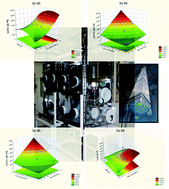Selenium is one of the fission products which we find in irradiated fuels. Selenium is a long life fission product, so it is of prime interest to determine precisely the quantity of 79Se produced during nuclear fuel irradiation. Indeed, this radio-isotope is one of the potential long term radio-contaminating elements, because of its capacity of migration in the various compartments of the ground. In this study, the influence of the experimental conditions of the inductively coupled plasma mass spectrometry (ICP-MS) technique for measurement of selenium was handled. The purpose is to optimize the numerous operating parameters to obtain the best conditions for selenium sensitivity and interference resolution. To determine the influence of the various parameters on the signal intensity, while limiting the number of experiments, experimental designs were performed. The final goal of this study is to know the optimal conditions for selenium measurement with optimization of the collision cell in order to eliminate Ar2+ interference by use of the correct reaction gas and operating parameters. A screening design was used to identify the influential parameters which were then studied in a deeper way with a Doehlert design. Optimization of parameters includes the choice of the reaction gas and buffer gas used in order to eliminate argon dimers that interfere with most of the selenium isotopes. A study of the operating parameters and gas flow rates (O2, O2/He, O2/Ne, O2/Ar and O2/N2) was performed using Doehlert designs. The influence of the studied parameters was studied on both a blank solution (to ensure complete resolution of Ar2+/Se+ interference) and on a natural selenium solution at 5 ng g−1 to find the best sensitivity. It is important to note that, for all gas couples, the same factors have the same influence on the signal. Optimal conditions were defined for the best gas mix O2/He (0.6/8 mL min−1) and a sensitivity of 8000 cps ppb−1 was obtained for 80Se. Then, these conditions were applied to the measurement of the 79Se in irradiated fuel dissolved in the Atalante facility and a concentration of 12.9 ng g−1 of solution ± 0.6 (k = 2) was measured.

You have access to this article
 Please wait while we load your content...
Something went wrong. Try again?
Please wait while we load your content...
Something went wrong. Try again?


 Please wait while we load your content...
Please wait while we load your content...